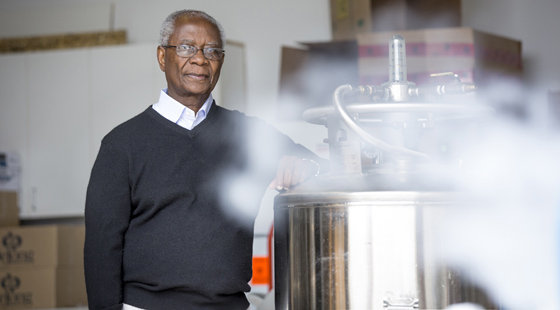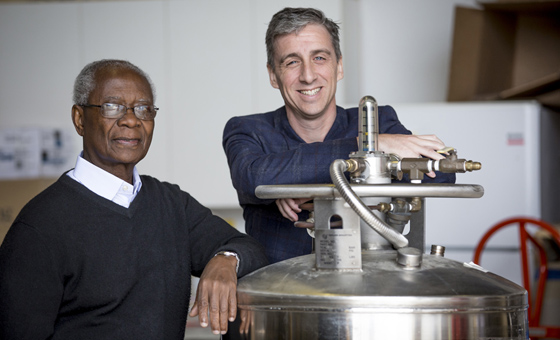
John Akabutu (MD’67): Progressive Practitioner
By Mark Campbell
Dr. John Akabutu was standing firm. It was the late 1980s – the height of the AIDS epidemic – and the pediatric hematology oncology specialist was being pressured by an Edmonton journalist to reveal the names of the hemophiliacs he was treating in Northern Alberta.
The reporter told him it was a matter of public health and safety. Yet Dr. Akabutu knew that revealing this information would put the lives of his patients in jeopardy. News reports from Florida made that clear; people had set fire to the houses of hemophiliac children who’d been exposed to the AIDS virus. Determined to prevent the spread of such fear to Alberta, he refused to cooperate. His resolve may have earned him snide remarks in Edmonton newspapers, but Dr. Akabutu has no regrets. “I was glad I did that. This was before confidentiality became as big as it is today. If I hadn’t stood up for my patients, they would have become victims. I’m proud that I took that stance.”
Dr. Akabutu has always stood up for his patients
He may not have instant recall of every name and face when it comes to the children he’s treated over the years – time has a way of blunting even the sharpest memory – but they remember him. Were it not for his pioneering spirit and his dedication to finding the most effective cures for leukemia and hemophilia, many would not be alive today. Yet in that quest, he never lost sight of the fact that he was treating people.
“Patients are not diseases; they are human beings. When you begin to refer to your patients by their diseases instead of calling them by name, I think you miss the essence of being a physician. You have to look at your patients as individuals with a problem, not as problems that happen to be individuals.”
Building a world view
Originally from Ghana, Dr. Akabutu arrived at Dalhousie University in 1962 to study medicine on a government scholarship. “My experience at the university was a very positive one,” he says. ”I received a first-rate education at both the undergraduate and professional school level. My teachers were also supportive and friendly and became good mentors to me. I matured as an adult at Dalhousie and developed my world view.”
When political upheaval precluded returning home, Dr. Akabutu decided to continue his studies in North America. Although Dalhousie inspired him to be a teacher and pursue academia in medicine, it was at the University of Cincinnati that he decided to focus on pediatric hematology/oncology. “When children get sick, they have pure diseases. They aren’t typically complicated with other problems, which is what happens with adults. I felt this would give me the opportunity to understand human afflictions in more detail without them being modified by other factors.”
Aiming for 100%
When Dr. Akabutu arrived at the University of Alberta to start a pediatric hematology oncology program in 1972, the survival rate among children with leukemia across Canada was less than 10%. He set his sights on 100%. Introducing a program of chemotherapy, he began to make considerable progress, yet too many children were still failing and more treatment options were needed, so Dr. Akabutu started looking for innovative solutions. When the field of bone marrow transplantation opened up, he was an early adopter. In the 1990s, he heard about a movement in the United States to introduce cord blood – blood cells from the umbilical cord – as an alternate source of stem cells for leukemia treatments. “I decided to go that route as well,” says Dr. Akabutu.
With the help of donations from the town of Eckville, Alberta, he launched the Alberta Cord Blood Bank, the first such bank in Canada, in 1996. It collects and provides stem cells for transplantations in Alberta, across Canada and around the world. By introducing the most modern approaches to blood and solid cancers, we were able to dramatically change the survival rate in kids with these diseases.” What Dr. Akabutu achieved wasn’t quite 100%, but it was close. By the time he retired as an active cancer specialist in 2002, the survival rate among children in Northern Alberta with the most common forms of leukemia was 95%. “And with the more difficult types of leukemia,” he adds, “we were getting survival rates between 60-70%, which was unheard of. Before that, all of these children died.”
Giving (and getting) back through teaching
Dr. Akabutu also made considerable headway in treating hemophiliacs through the introduction of a preventative homecare program. By getting children and parents involved in managing their condition, he reasoned, he could reduce their emergency room visits and prevent debilitating joint damage. He succeeded.
“Traditionally, the hallmark of hemophilia was crippling joint deformities. But if you see many of my patients in the streets today, you wouldn’t know that they had hemophilia. Being able to transform the quality of life of children with hemophilia is probably one of the greatest satisfactions I have had next to the survival rates we achieved among children with cancer.”
 Now professor emeritus and researcher at the University of Alberta, Dr. Akabutu has imparted his love of pediatrics to many of his students over the years. He estimates 50% of the specialists employed in the pediatric hematology oncology department at the University of Alberta studied under him and says nurturing them has been a rewarding experience. “When you teach, you get as much back as you give. You get to watch young people build confidence and become your colleagues. That is tremendous.”
Now professor emeritus and researcher at the University of Alberta, Dr. Akabutu has imparted his love of pediatrics to many of his students over the years. He estimates 50% of the specialists employed in the pediatric hematology oncology department at the University of Alberta studied under him and says nurturing them has been a rewarding experience. “When you teach, you get as much back as you give. You get to watch young people build confidence and become your colleagues. That is tremendous.”
It’s also a great way to remain at the leading edge of the field. “That’s part of why I became a teacher – to be associated with the changes that are inevitable in our knowledge. That way you progress and you continue to learn every day. It’s an inexpensive way to be a perpetual student.”
A better tomorrow for all
Even in retirement, Dr. Akabutu is still learning, always looking for that leading edge. He continues to oversee the cord blood bank he established and is looking at other uses for these stem cells. He’s also taken an active interest in predictive healthcare – the prevention of diseases before they occur. “It’s a very young field. There’s a lot of work to be done, but with the completion of the human genome project that has opened the door for us to be able to pursue that, and it will benefit everyone.”
Meanwhile, Dr. Akabutu has also reconnected with Dalhousie and his Class of ’67 colleagues, thanks in part to a campus visit in 2013 to receive the Alumnus of the Year award from the Dalhousie Medical Alumni Association. It’s an honour he holds dear. “Dalhousie made me what I am today. To say otherwise would be an injustice to the institution.”
When asked what he’d like to be remembered for, Dr. Akabutu is modest. “I’ve derived incredible joy from being a physician and a teacher. I hope that through a little bit of what I’ve done we’ll have a better tomorrow for all of us. And I hope people will say that I always tried my best.”


